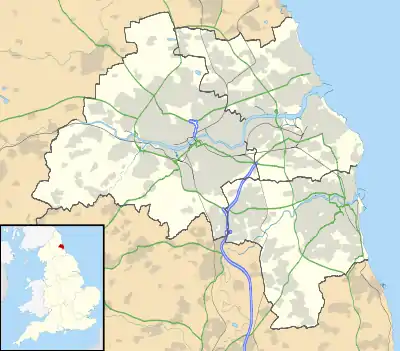Prestwick Carr
Prestwick Carr is a large area of low-lying wetland on the northern boundary of the city of Newcastle-upon-Tyne in northeastern England between Dinnington and Ponteland. It is known for attracting various birds of wetlands and open country and is an Site of Special Scientific Interest[1] and a nature reserve managed by the Northumberland Wildlife Trust. A large part of the site is owned by the Ministry of Defence.[2]
| Prestwick Carr | |
|---|---|
 Prestwick Carr SSSI plantation (afar) | |
 Location in Tyne and Wear | |
| Location | Tyne and Wear, England, UK |
| OS grid | NZ195735 |
| Coordinates | 55.056°N 1.696°W |
Description and vegetation
Prestwick Carr sits within a low lying basin of peat to the north west of Newcastle-upon-Tyne. Within the site there are a range of wetland habitats including tall fen with soft rush and reed canary-grass, Common alder and downy birch dominated carr and a raised bog which is now surrounded by a coniferous forestry plantation. These wetlands were more extensive in the past but drainage has reduced their extent. The remaining open water supports a variety of aquatic species and the relict raised bog supports the rare bog rosemary.[1]
Birds
Prestwick Carr holds wildfowl and waders in the winter and has breeding Water rail, Eurasian skylark, willow tit and meadow pipit in summer. Barn owls and short-eared owls are also found there.[2][3] In 1853 a pair of wood sandpiper were recorded as nesting at Prestwick Carr, an unusual record for England.[4] In 2019-20 an Eastern yellow wagtail spent the winter at this site, part of an influx to Britain that winter.[5] Other unusual records have included great grey shrike and little gull.[3]
Dragonflies
Prestwick Carr also holds dragonflies and the first records in Northumberland of four-spotted chaser and common darter were made there by early naturalists.[6]
References
- "Prestwick Carr" (PDF). English Nature. Retrieved 16 March 2020.
- "Prestwick Carr". Northumberland Wildlife Trust. Retrieved 16 March 2020.
- Andy Mould, ed. (2017). Birds in Northumbria 2016 (PDF). Northumberland and Tyneside Bird Club.
- Kenna Chisholm (2007). "History of the wood sandpiper as a breeding bird in Britain" (PDF). British Birds. 100 (2): 112–121.
- Barry Nightingale & Harry Hussey (2020). "Recent reports". British Birds. 113 (3): 287–188.
- Harry T. Eales (2016). "Dragonflies and Damselflies of Northumberland and Durham" (PDF). Transactions of the Natural History Society of Northumbria. 81.
